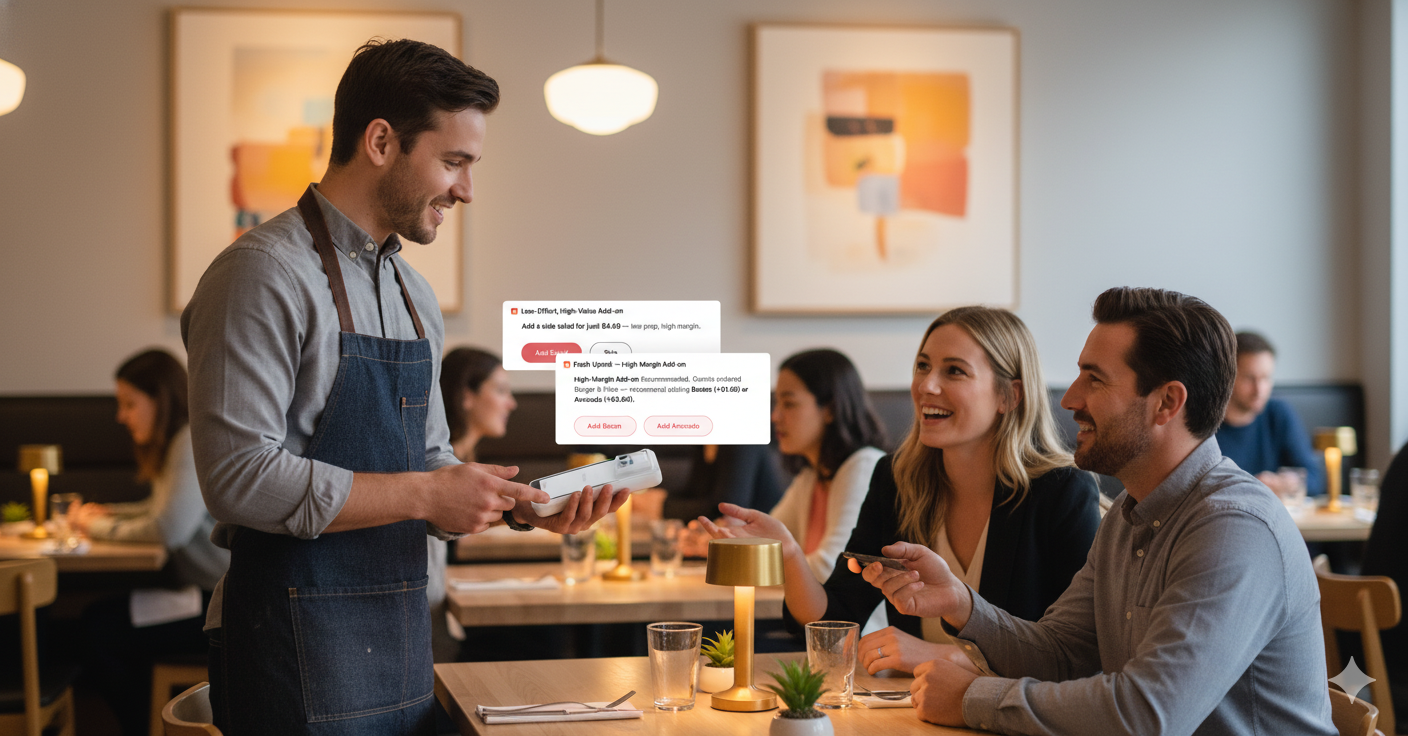
Restaurant Menu Design: The Complete Guide to Driving Sales, Enhancing Guest Experience, and Building Your Brand
Did you know that simply renaming dishes with more evocative language can increase sales by 28%, with guests even willing to pay 12% more? In a Cornell study, transforming “seafood filet” into “Succulent Italian Seafood Filet” had that exact effect.
Your menu isn’t just a list, it’s the voice of your restaurant. It sets expectations, stirs appetites, and guides decisions long before anyone walks in. At a time when margins are razor-thin, using thoughtful restaurant menu design is one of the smartest, leanest ways to boost profits and reinforce your brand.
In this guide, we’ll unpack why menu design matters, how menu psychology plays a role in guest choices, and share straightforward design and engineering tips you can apply right away. You’ll also learn about common pitfalls, the power of digital menus, and how NOVA helps you design menus that delight guests and grow your business, all without overhauling your operations.
What Is Restaurant Menu Design?
At its core, designing a menu is about more than fonts, colors, and pictures. It’s the art and science of presenting your dishes in a way that maximizes sales, enhances the guest experience, and reinforces your brand identity.
Think of menu design in two layers:
- Visual Layout: The structure, typography, imagery, and grouping of items.
- Strategic Structure: Where each item is placed, how pricing is framed, and which dishes are highlighted.
This is where menu engineering comes in. While design makes your menu attractive, engineering makes it profitable. It’s about knowing which dishes are “stars” (high profit, high popularity), which are “puzzles” (high profit, low popularity), and which are “dogs” (low profit, low popularity) that might need to be removed. Together, design and engineering form the backbone of a winning restaurant menu.
The Psychology of Restaurant Menu Design
Guests don’t read menus like books; they scan them. Understanding this behavior is key to influencing their choices. Here are some psychological principles that smart restaurants use:
- The Golden Triangle: Research shows that when looking at a menu, eyes first move to the center, then the top right, then the top left. These are your “sweet spots” for placing high-margin dishes.
- Z-Pattern Scanning: On longer menus, guests often scan in a Z-shape from top left to bottom right. Strategic item placement can guide their decisions naturally.
- Colors and Appetite: Warm colors like red and yellow stimulate appetite and urgency, while green signals freshness and health. The color scheme of your menu can subtly reinforce your brand.
- Anchoring and Decoy Pricing: Listing a very high-priced item at the top makes other dishes seem more affordable in comparison. Similarly, adding a “decoy” item can drive guests toward the option you want them to pick.
- Choice Limitation: Too many options overwhelm guests and slow decisions. By curating your menu to focus on the right number of items, you reduce fatigue and increase satisfaction.
The smartest restaurant menu design uses these principles not to trick guests, but to make decision-making effortless and enjoyable.
Core Principles of an Effective Restaurant Menu Design
Once you understand the psychology, it’s time to apply menu design principles that work:
- Layout & Structure: Group categories logically: starters, mains, desserts, beverages. Avoid clutter. A clean, structured layout increases sales.
- Typography & Readability: Use fonts that are easy on the eyes. Overly stylized text might look fancy, but it hurts readability.
- Descriptions: Write in a way that paints a picture. “Tender, slow-braised lamb in rosemary jus” will sell more than “Lamb Curry.” Vivid, sensory language builds anticipation.
- Highlighting High-Margin Items: Use boxes, icons, or “chef’s recommendations” to draw attention to dishes that drive restaurant profitability.
- Photos: A few high-quality photos can boost sales, but too many can cheapen the feel. Upscale restaurants often avoid pictures altogether, while casual spots can benefit from tasteful visuals. Usually, menu items that feature a photo beside them typically sell 6.5% more than items listed without images.
These principles create menus that are both easy to navigate and strategically aligned with your business goals.
Menu Engineering: Turning Design into Strategy
Restaurant menu design without a strategy is decoration. This is where menu engineering comes into play. It’s about using data and psychology together to optimize profit and popularity.
- Identify Star Items: Dishes that are both profitable and popular should be placed on the menu hotspots and highlighted visually.
- Rework Puzzles: High-margin but low-popularity items may need better placement, improved descriptions, or even bundling.
- De-Emphasize Dogs: Low-margin, low-popularity dishes clutter your menu. Consider phasing them out.
- Pricing Strategies: Removing currency signs, using charm pricing ($9.95 instead of $10), or anchoring with premium items can influence spending behavior.
For example, placing your most profitable pasta dish in the top-right corner, paired with an evocative description, can shift buying patterns in your favor. This is where analytics tools like NOVA’s make the difference, giving you visibility into what’s really working.
Common Menu Design Mistakes That Hurt Sales
Even with the best intentions, many restaurants fall into these traps:
- Overloading the Menu: Too many items overwhelm guests and increase kitchen inefficiencies. Chains like Starbucks, Papa John’s, and Chili’s have all been cutting back their menus. The reason is simple: a leaner menu lowers ingredient and labor costs, helps maintain consistency and quality, and makes it easier to spotlight high-margin items that drive profitability.
- Inconsistent Restaurant Branding: If your restaurant has a rustic, homely vibe but your menu looks corporate, guests feel a disconnect.
- Neglecting Updates: Menus should evolve with seasons, ingredient costs, and guest preferences. A static menu is a stale menu.
- Unclear Add-ons or Charges: Guests hate surprises. Service charges, extra toppings, or fees must be communicated clearly. Lack of transparency erodes trust.
Avoiding these mistakes can immediately elevate your restaurant menu design and guest perception.
The Rise of Digital Menu Design
The pandemic accelerated a shift toward digital menus, and they’re here to stay. But restaurant menu designs aren’t just about scanning a QR code, they’re about creating interactive, dynamic guest experiences.
Benefits include:
- Instant Updates: Adjust prices or add specials in real time without reprinting.
- Lower Costs: Save on design and printing while maintaining consistency.
- Guest Experience: Offer allergen filters, upsell recommendations, and suggested pairings.
- Scalability: For multi-location operators, digital menus ensure uniformity across outlets.
Almost 70% restaurants in the U.S. are using QR code menus, and they quickly became the preferred choice for younger diners, favored by 68% of Gen Z. A well-designed digital restaurant menu doesn’t just replicate paper; it enhances the guest journey while giving you operational flexibility.
How NOVA Helps Restaurants Elevate Menu Design
At NOVA, we’ve built our POS with menu design and engineering in mind. Here’s how we help restaurants gain the edge:
- AI-Native Insights: Identify best-sellers, underperformers, and margin drivers automatically.
- Dynamic Digital Menus: Seamlessly update in-house, online, and delivery menus in one place.
- Brand Consistency: Create a unified restaurant menu layout that reflects your identity across all channels.
- Integrated Promotions: Highlight specials, seasonal offers, or bundles directly on menus.
- Transparency: Make service charges, add-ons, and pricing clear, building guest trust.
With NOVA, restaurant menu design becomes less guesswork and more science, helping you increase sales and strengthen your brand with every update.
Design Smarter Menus, Run a Smarter Restaurant
Your menu is more than a piece of paper or a digital screen; it’s one of your most powerful business tools. Smart restaurant menu design drives sales, enhances guest experience, and communicates your brand in ways no other touchpoint can.
As a restaurant owner, now is the time to audit your menu. Is it guiding guests toward your best dishes? Does it reflect your brand identity? Is it helping or hurting your margins?
At NOVA, we believe designing and managing menus shouldn’t be a guessing game. With the right mix of psychology, design principles, and data-driven insights, you can turn your menu into a growth engine. And with NOVA’s tools, you don’t have to do it alone; we help you build menus that not only look great but also work harder for your business.
FAQs on Restaurant Menu Design
What is restaurant menu design?
Restaurant menu design goes beyond listing food items; it’s the intentional process of arranging, styling, and presenting your menu so it’s both visually appealing and strategically effective. It combines layout, typography, pricing, descriptions, and branding to create a menu that guides guest choices and reinforces your restaurant’s identity.
How does restaurant menu design increase sales?
A well-structured menu uses psychology and visual cues to direct attention toward high-margin dishes, encouraging guests to choose items that benefit both them and the restaurant. From decoy pricing to “sweet spot” placement, the design influences decisions, which can lead to a 10–20% increase in profitability without changing your operations.
What are the principles of effective restaurant menu design?
Strong restaurant menu design rests on clarity, readability, and strategic placement. Grouping items logically, using sensory-rich descriptions, and drawing subtle attention to signature or profitable dishes with icons, highlights, or boxes helps guests feel confident in their choices. The design should also reflect your restaurant’s personality to strengthen brand recall.
How often should I redesign my restaurant menu?
Most restaurants should evaluate their menu at least every three to four months, using sales data to identify what’s working and what isn’t. Seasonal updates and occasional design refreshes not only keep the menu profitable but also show guests that the restaurant is evolving and offering something new.
What is menu engineering?
Menu engineering is the practice of analyzing both the popularity and profitability of each menu item to decide which dishes should be promoted, redesigned, or removed. It transforms your menu from a static list into a performance-driven tool, ensuring you maximize both customer satisfaction and restaurant margins.


.png)


